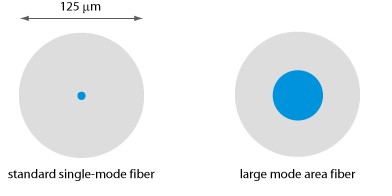Categories
Latest Blog
Large Core Fibers
The core of a fiber is the region in which
the light is guided, i.e., it is responsible for the waveguiding effect. Usually,
the core is a region of slightly increased refractive index, obtained not by
using an entirely different glass, but by doping the glass with some
index-raising material. In the case of silica fibers, typical index-raising
dopants are germania (GeO2, germanosilicate fibers), phosphorus pentoxide
(P2O5, phosphosilicate), and alumina (Al2O3, aluminosilicate). Alternatively or
in addition, the index of the cladding may be lowered e.g. by fluorine or boron
oxide (B2O3) doping. Index-lowering agents can also be used in the core if
other required dopants make the index difference too high.
Additional dopants are required for active
fibers, i.e., for fibers which can be used for fiber amplifiers or lasers. In
almost all cases, these dopants contain rare earth ions such as Er3+ (erbium),
Yb3+ (ytterbium) or Nd3+ (neodymium). In addition to these ions, other
ingredients are often used, e.g. for reducing quenching or photodarkening
effects.
The waveguiding properties are determined
by the refractive index profile, i.e., the increase in refractive index in the
core relative to that of the cladding. For step-index profiles, the numerical
aperture and the V number are frequently used parameters.
Although the fiber core is rotationally
symmetrical for most fibers, there are methods to break this symmetry e.g. by
using an elliptical core and/or by introducing asymmetric structures around the
core. This can lead to strong birefringence (→ polarization-maintaining fibers)
and even to polarization-dependent guidance (→ single-polarization fibers).
In most cases, the fiber core is located at
the center of the fiber's cross-section, because this facilitates splicing,
launching light, the use of fiber connectors and other fiber joints, etc.
However, for double-clad fibers it can be very advantageous to use an
off-centered core, because this can substantially improve the pump absorption.
In rare cases, helical core fibers are used where the core winds around the
fiber axis.
A large-core fiber is an optical fiber having a fiber core which is relatively large. It can be a multimode fiber or a single-mode fiber.
Large-core Multimode Fibers
Large-core multimode fibers have a core diameter which is well above the typically used 50 μm or 62.5 μm of telecom fibers – for example, 100 μm or even 400 μm. The core is often not much smaller than the fiber cladding (see Figure 1). The cladding diameter may substantially go beyond the usual 125 μm in order to realize even larger cores. The number of guided fiber modes is then usually very high.
Design of a large-mode multimode fiber with 105 μm core diameter and 125 μm cladding diameter.
Frequently, such fibers have a pure silica fiber core (rather
than e.g. a germanosilicate core) and a fiber
cladding with somewhat reduced refractive index, e.g. achieved with fluorine doping.
For realizing a high numerical aperture, however, one may still use
fibers with germanosilicate core.
Typical applications of large-core multimode
fibers are the passive transport of light e.g. in the context of illumination, laser material processing or optical pumping of solid-state lasers.
Large-core Single-mode Fibers
If a large-core fiber is a single-mode fiber, it also has a large effective mode area . Here, the termlarge mode area fiber is more common and more appropriate, since the large mode area is a particularly important property: it results in reduced nonlinear effects combined with a high beam quality.
Comparison of bare (uncoated) fibers with a standard core size (e.g. 8 μm diameter) and a large core (50 μm diameter).

For those large diameter fibers, we need to use a LDF splicer to splice,like Fujikura 100M, Shinho S-27 LDF etc.
© Copyright: SHINHO OPTICS LIMITED All Rights Reserved.